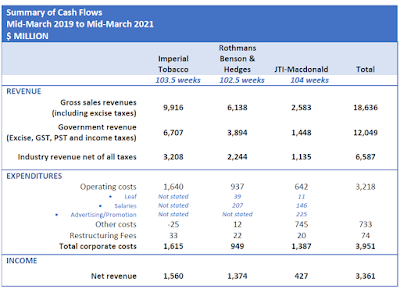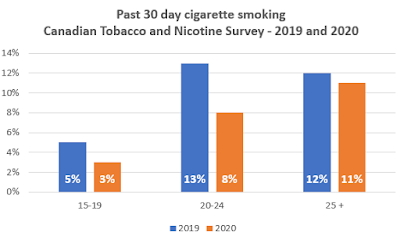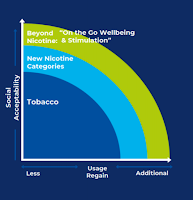During COVID, the World Health Organization came under frequent and nasty attacks over its scientific advice and policy recommendations. It now looks like similar attacks are underway on its scientific advance and policy recommendations on tobacco.
The issue is the reluctance of the World Health Organization (and the Framework Convention on Tobacco Control) to endorse the use of e-cigarettes as part of a tobacco-reduction approach. The catalyst is the upcoming report of the WHO Study Group on Tobacco Product Regulation (aka TobReg).
For over 20 years, the WHO has commissioned a panel of scientists to provide advice on ways to regulate tobacco products. ("to advise WHO about scientifically sound recommendations to Member States addressing the most effective and evidence-based means in order to fill regulatory gaps in tobacco control and achieve a coordinated regulatory framework for tobacco products.") This panel of scientists includes physicians, public health experts, toxicologists and other bench scientists and regulatory experts.
Theirs is not an enviable job. Translating science to health policy is not easy at the best of times, let alone when trying to regulate an industry that has the scientific upper-hand and the willingness to exploit it.
For the most part, TobReg has kept out of the limelight, drawing little interest or opposition, even when they provided strong advice on key regulatory concerns, like how to reduce the attractiveness and addictiveness of tobacco products.
Their 8th report, however, has drawn fire before it has even been published.
Special meetings of British parliamentarians have been held .
Tabloids have been alerted.
Lengthy briefs have been written.
The trigger for this public relations onslaught was fired with the WHO Executive Board was given advance notice of the recommendations that would be in the report on TobReg's 10th meeting.
Extracts from that report (pasted below) show that this group of scientists are urging countries to stay the course in implementing FCTC measures, and to ensure that heated tobacco products (like IQOS) are not misleadingly marketed.
With respect to e-cigarettes, TobReg came to 4 conclusions:
1. there should be a ban on commercial advertising by manufacturers and their agents;
2. that e-cigarettes should not be allowed to provide higher amounts of nicotine than cigarettes
3. that vaping liquids that blend cannabis and nicotine should be banned
4. that open-systems that allow for users to tinker with dosages should be banned.
In arriving at these recommendations, the panel reviewed 9 commissioned background papers. Even before these reports and the other evidence used by the committee are made public, their recommendations do not seem out of line with those made by other independent scientists and analysts.
Some opponents of the World Health Organization and some proponents of vaping appear to be using the upcoming report as a way to challenge both the credibility of the WHO and the evidentiary basis for nicotine regulation. These campaigners have already succeeded in having U.K. Parliamentarians consider whether the World Health Organization is "fit for purpose".
The focal point for their campaign is this fall's Conference of Parties, when government representatives meet to plan the next steps in implementing the Framework Convention on Tobacco Control.
This mobilization effort, with its exaggerated claims and challenge to science, is reminiscent of past campaigns launched by the industry against smoke-free spaces, advertising bans. If you can't change the facts, then give a beating to those who are talking about them in the hopes you will scare off those with real power.
Plus ça change....
----------------------
From: WHO.
Report on meetings of expert committees and study groups. EB148/47
Report of the tenth meeting of the WHO Study Group on Tobacco Product Regulation,
virtual meeting - 28 September–2 October 2020
27. The tenth meeting of the Study Group discussed nine background papers on the following areas:
- toxicants in heated tobacco products: exposure, health effects and examination of the claims of reduced
risk
- the attractiveness and addictive potential of heated tobacco products: effects on perception and use
and associated effects
- variability of heated tobacco products: considerations and implications
- regulatory mapping of heated tobacco products, including country approaches, barriers to regulation and
regulatory considerations
- exploration of the methods available for the quantification of individual
health risk and application of these methods to electronic nicotine delivery systems
- evaluation of
population health impact and implications for regulation
- estimation of nicotine exposure from use of
electronic nicotine delivery systems compared with that from conventional cigarettes; flavours in novel
and emerging nicotine and tobacco products and traditional products
- use of heated tobacco products: switching and dual and poly use of tobacco products
- and global landscape of novel and emerging
nicotine and tobacco products marketing, promotion and associated impacts.
In addition, the Study
Group discussed two horizon scanning papers on:
- nicotine forms in the tobacco plant, chemical
modifications and implications for electronic nicotine delivery systems;
- and e-cigarette, or vaping,
product use associated lung injury.
The information from these papers will update knowledge and
advance nicotine and tobacco product regulation in order to inform policy at global level.
Main recommendations
29. The main recommendations to policy-makers and all other interested parties include, but are not
limited to, the following:
(a) to maintain focus on evidence-based measures to reduce tobacco use as outlined in the
WHO Framework Convention on Tobacco Control and seek to avoid being distracted from these
actions by the promotion of novel tobacco products such as heated tobacco products;
(b) to use existing regulations for tobacco products to regulate heated tobacco products
(including the device) and consider broadening the scope of the existing regulations, where
regulatory loopholes may be exploited by the tobacco industry, including in countries in which
these tobacco products are currently not legally available;
(c) to apply the most restrictive tobacco control regulations to heated tobacco products
(including the device), as appropriate within national laws, taking into account the need for a high
level of protection for human health;
(d) to prohibit all manufacturers and associated groups from making claims about reduced
harm of heated tobacco products, compared with other products, or portraying heated tobacco
products as an appropriate approach for cessation of any tobacco product and ban their use in
public spaces unless robust independent evidence emerges to support a change in policy;
(e) to ensure that the public is well informed about the risks associated with use of heated
tobacco products, including the risks of dual use with conventional cigarettes and other smoked
tobacco products, and also their use during pregnancy; to correct false perceptions, counter
misinformation and clarify that reduced exposure does not necessarily mean reduced harm;
(f) to rely on independent data and to support continuing independent research on the public
health impact of heated tobacco products, along with critically analysing and interpreting tobacco
industry-funded data, including but not limited to research data pertaining to emissions and
toxicity of heated tobacco products and associated exposures and effects in users and non-users;
(g) to require tobacco manufacturers to disclose all product information – including product
design, chemical profile, total nicotine content, nicotine forms, toxicity, other findings of product
testing and testing methods – to appropriate regulatory agencies at least once a year; any
modifications to products should require an updated report;
(h) to ban all activities related to the commercial marketing of electronic nicotine delivery
systems, electronic non-nicotine delivery systems and heated tobacco products, including in
social media and through organizations funded by and associated with the tobacco industry;
(i) to prohibit electronic nicotine delivery systems and electronic non-nicotine delivery
systems over which the user can control device features and liquid ingredients (that is, open
systems);
(j) to prohibit the sale of electronic nicotine delivery systems that have a higher abuse liability
than conventional cigarettes, for example by restricting the emission rate or/flux of nicotine; and
(k) to prohibit the addition of pharmacologically active substances (in jurisdictions where they
are legal) other than nicotine in electronic nicotine delivery systems, such as cannabis and
tetrahydrocannabinol to electronic nicotine delivery systems and electronic non-nicotine delivery
systems.

















